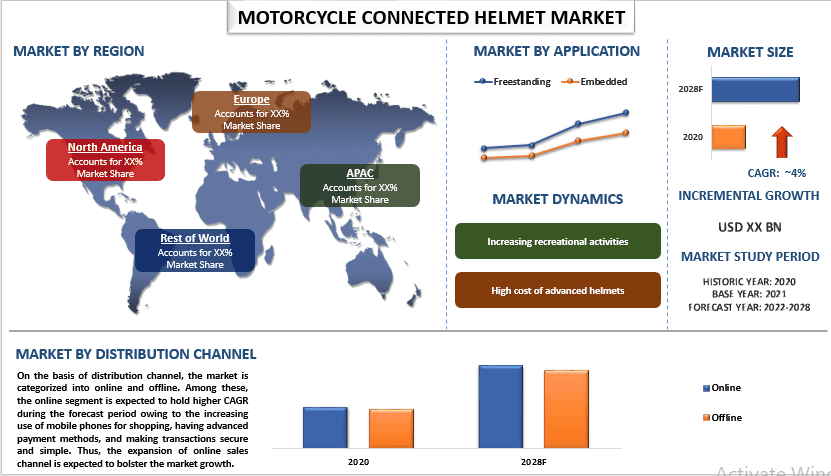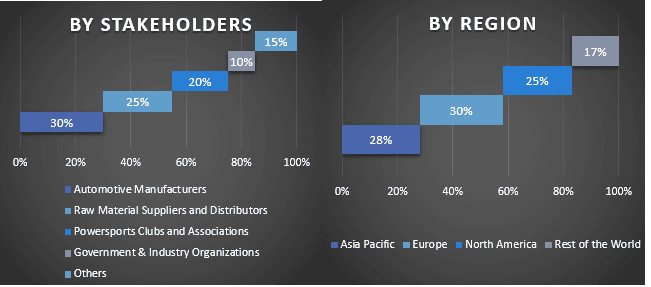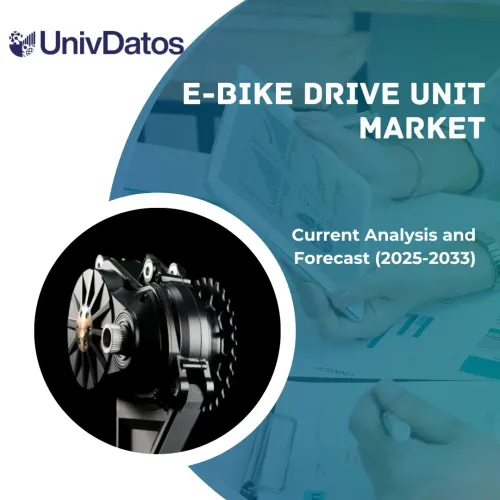- Accueil
- À propos de nous
- Industrie
- Services
- Lecture
- Contactez-nous
Marché des casques connectés pour motos : Analyse actuelle et prévisions (2022-2028)
Accent mis sur l'application (autonome et embarquée) ; Canal de distribution (en ligne et hors ligne) ; et Région/Pays

DEMANDER UN EXEMPLE DE PDF GRATUIT
Le marché mondial des casques connectés pour motos devrait croître à un rythme important d'environ 4 % au cours de la période de prévision. Les casques de moto sont considérés comme un équipement de sécurité essentiel par de nombreux motocyclistes. Les casques doivent utiliser l'équipement pour la sécurité et les caractéristiques avancées des casques connectés les rendent très fiables. De plus, de nombreux fabricants de casques de moto ont mis au point des caractéristiques haut de gamme pour encourager les consommateurs à porter un casque. Le nombre croissant de motos et de passionnés de motos de sport, l'augmentation des cas d'accidents et les progrès technologiques sont les principaux facteurs de croissance du marché. Par exemple, en janvier 2020, Tali Helmet a lancé le CES 2020. Le casque est entouré de LED à changement de couleur pour une meilleure visibilité, avec des fonctions comprenant un feu de freinage arrière et des clignotants. Couplé via Bluetooth à votre téléphone intelligent, le Tali peut non seulement lire de la musique, prendre des appels téléphoniques ou lire des instructions de navigation, mais il peut aussi automatiquement appeler les services d'urgence en cas de chute ou d'accident.
Bayerische Motoren Werke AG, BITwave Pte. Ltd, Dainese S.p.A, Visa Outdoor Operations LLC, HJC Helmets, UCLEAR Digital, AIROH, Shelliostech, Reevu America et Schuberth GmbH sont quelques-uns des principaux acteurs du marché. Plusieurs fusions et acquisitions ainsi que des partenariats ont été entrepris par ces acteurs pour faciliter l'accès des clients à des produits/technologies de haute technologie et innovants.
Aperçus présentés dans le rapport
« Parmi les applications, la catégorie intégrée détiendra une part importante du marché en 2020 »
Selon l'application, le marché est segmenté en autonome et intégré. La catégorie intégré détenait une part importante du marché en 2020. Les casques intégrés offrent la sécurité, la facilité de communication, le GPS et l'envoi et la réception de messages texte, ce qui aide le motocycliste à ne pas être dérangé pendant la conduite et à maintenir une conduite sûre et sécurisée. Par conséquent, ce sont les facteurs qui stimulent la croissance du marché.
« Parmi les canaux de distribution, la vente en ligne détiendra une part importante du marché en 2020 »
Selon le canal de distribution, le marché est classé en ligne et hors ligne. Parmi ceux-ci, le segment en ligne devrait croître avec un TCAC plus élevé au cours de la période de prévision en raison de l'utilisation croissante des téléphones mobiles pour les achats, des méthodes de paiement avancées et de la sécurisation et de la simplification des transactions. Ainsi, l'expansion du canal de vente en ligne devrait stimuler la croissance du marché.
« La région APAC connaîtra une croissance avec un TCAC plus élevé au cours de la période de prévision »
Pour une meilleure compréhension de l'adoption du marché de l'industrie des casques connectés pour motos, le marché est analysé en fonction de sa présence mondiale dans des pays tels que l'Amérique du Nord (États-Unis, Canada, reste de l'Amérique du Nord), l'Europe (Allemagne, Royaume-Uni, France, Espagne, Italie, reste de l'Europe), Asie-Pacifique (Chine, Japon, Inde, reste de l'Asie-Pacifique), reste du monde. La région APAC devrait croître à un TCAC important au cours de la période de prévision. Le marché chinois des casques de moto a évolué et représente une part de marché importante. Les efforts visant à réduire l'utilisation des deux-roues à essence et à contrôler la pollution dans certaines des principales villes ont entraîné une baisse du nombre de motos dans le pays. Cependant, la demande de casques est en hausse en raison de la croissance des deux-roues électriques. L'Inde est le marché des casques de moto qui connaît la croissance la plus rapide en Asie-Pacifique en raison du grand nombre d'acheteurs de deux-roues dans le pays. La croissance de l'industrie du casque est non seulement menée par les motos de banlieue, mais aussi par les deux-roues plus gros et plus chers. De plus, le développement des infrastructures dans les zones rurales stimule également la vente de deux-roues et, par conséquent, devrait stimuler la demande de casques. Les gouvernements du monde entier prennent les mesures nécessaires pour éviter le nombre croissant de décès causés par les accidents de la route. Par exemple, le gouvernement indien a adopté une loi sur l'utilisation de casques dans les villes de deuxième et troisième rangs afin d'assurer la sécurité routière.
Raisons d'acheter ce rapport :
- L'étude comprend une analyse de la taille du marché et des prévisions validée par des experts clés authentifiés de l'industrie.
- Le rapport présente un aperçu rapide de la performance globale de l'industrie en un coup d'œil.
- Le rapport couvre une analyse approfondie des principaux pairs de l'industrie en mettant l'accent sur les principales données financières de l'entreprise, le portefeuille de produits, les stratégies d'expansion et les développements récents.
- Examen détaillé des moteurs, des contraintes, des tendances clés et des opportunités qui prévalent dans l'industrie.
- L'étude couvre de manière exhaustive le marché à travers différents segments.
- Analyse approfondie au niveau régional de l'industrie.
Options de personnalisation :
Le casque connecté pour moto mondial peut en outre être personnalisé selon les exigences ou tout autre segment de marché. En outre, UMI comprend que vous pouvez avoir vos propres besoins commerciaux, alors n'hésitez pas à communiquer avec nous pour obtenir un rapport qui répond parfaitement à vos exigences.
Table des matières
Méthodologie de recherche pour l'analyse des casques connectés pour motos (2022-2028)
L'analyse du marché historique, l'estimation du marché actuel et la prévision du marché futur du casque connecté pour motos à l'échelle mondiale ont été les trois principales étapes entreprises pour créer et analyser l'adoption des casques connectés pour motos dans les principales régions du monde. Une recherche secondaire exhaustive a été menée pour collecter les chiffres du marché historique et estimer la taille actuelle du marché. Deuxièmement, pour valider ces informations, de nombreuses conclusions et hypothèses ont été prises en considération. De plus, des entretiens primaires exhaustifs ont également été menés avec des experts de l'industrie à travers la chaîne de valeur du casque connecté pour motos à l'échelle mondiale. Après l'hypothèse et la validation des chiffres du marché par le biais d'entretiens primaires, nous avons employé une approche descendante/ascendante pour prévoir la taille complète du marché. Par la suite, des méthodes de ventilation du marché et de triangulation des données ont été adoptées pour estimer et analyser la taille du marché des segments et sous-segments de l'industrie en question. La méthodologie détaillée est expliquée ci-dessous :
DEMANDER UN EXEMPLE DE PDF GRATUIT
Analyse de la taille du marché historique
Étape 1 : Étude approfondie des sources secondaires :
Une étude secondaire détaillée a été menée pour obtenir la taille du marché historique du casque connecté pour motos à travers des sources internes à l'entreprise telles que les rapports annuels et états financiers, présentations de performance, communiqués de presse, etc., et des sources externes, notamment les revues, actualités et articles, publications gouvernementales, publications des concurrents, rapports sectoriels, base de données tierce et autres publications crédibles.
Étape 2 : Segmentation du marché :
Après avoir obtenu la taille du marché historique du casque connecté pour motos, nous avons mené une analyse secondaire détaillée pour recueillir des informations et des parts de marché historiques pour différents segments et sous-segments pour les principales régions. Les principaux segments inclus dans le rapport sont l'application et le canal de distribution. D'autres analyses au niveau des pays ont été menées pour évaluer l'adoption globale des modèles de test dans cette région.
Étape 3 : Analyse des facteurs :
Après avoir acquis la taille du marché historique des différents segments et sous-segments, nous avons mené une analyse des facteurs détaillée pour estimer la taille actuelle du marché du casque connecté pour motos. De plus, nous avons mené une analyse des facteurs à l'aide de variables dépendantes et indépendantes telles que l'application et le canal de distribution du casque connecté pour motos. Une analyse approfondie a été menée pour les scénarios de demande et d'offre en tenant compte des principaux partenariats, fusions et acquisitions, expansion commerciale et lancements de produits dans le secteur des casques connectés pour motos à travers le monde.
Estimation et prévision de la taille actuelle du marché
Détermination de la taille actuelle du marché : sur la base des informations exploitables des 3 étapes ci-dessus, nous sommes arrivés à la taille actuelle du marché, aux principaux acteurs du casque connecté pour motos à l'échelle mondiale et aux parts de marché des segments. Tous les pourcentages de parts requis et les ventilations du marché ont été déterminés à l'aide de l'approche secondaire mentionnée ci-dessus et ont été vérifiés par des entretiens primaires.
Estimation et prévision : pour l'estimation et la prévision du marché, des pondérations ont été attribuées à différents facteurs, notamment les moteurs et les tendances, les contraintes et les opportunités disponibles pour les parties prenantes. Après avoir analysé ces facteurs, les techniques de prévision pertinentes, c'est-à-dire l'approche descendante/ascendante, ont été appliquées pour arriver à la prévision du marché pour 2028 pour différents segments et sous-segments sur les principaux marchés à l'échelle mondiale. La méthodologie de recherche adoptée pour estimer la taille du marché comprend :
- La taille du marché de l'industrie, en termes de chiffre d'affaires (USD) et le taux d'adoption du casque connecté pour motos sur les principaux marchés nationaux
- Toutes les parts de pourcentage, les divisions et les ventilations des segments et sous-segments du marché
- Principaux acteurs du casque connecté pour motos à l'échelle mondiale en termes de produits offerts. De plus, les stratégies de croissance adoptées par ces acteurs pour concurrencer sur le marché en croissance rapide
Validation de la taille et de la part du marché
Recherche primaire : des entretiens approfondis ont été menés avec les principaux leaders d'opinion (KOL), y compris les cadres supérieurs (CXO/VP, chef des ventes, chef du marketing, chef des opérations, chef régional, chef de pays, etc.) dans les principales régions. Les résultats de la recherche primaire ont ensuite été résumés et une analyse statistique a été effectuée pour prouver l'hypothèse énoncée. Les contributions de la recherche primaire ont été consolidées avec les résultats secondaires, transformant ainsi l'information en connaissances exploitables.
Répartition des participants primaires dans différentes régions

Ingénierie du marché
La technique de triangulation des données a été utilisée pour achever l'estimation globale du marché et pour arriver à des chiffres statistiques précis pour chaque segment et sous-segment du casque connecté pour motos à l'échelle mondiale. Les données ont été divisées en plusieurs segments et sous-segments après avoir étudié divers paramètres et tendances dans les domaines de l'application et du canal de distribution dans le casque connecté pour motos à l'échelle mondiale.
L'objectif principal de l'étude mondiale sur les casques connectés pour motos
Les tendances actuelles et futures du marché du casque connecté pour motos à l'échelle mondiale ont été mises en évidence dans l'étude. Les investisseurs peuvent acquérir des connaissances stratégiques pour fonder leur discrétion pour les investissements sur l'analyse qualitative et quantitative effectuée dans l'étude. Les tendances actuelles et futures du marché ont déterminé l'attractivité globale du marché au niveau régional, offrant une plate-forme au participant industriel pour exploiter le marché inexploité afin de bénéficier d'un avantage de premier plan. Les autres objectifs quantitatifs des études comprennent :
- Analyser la taille actuelle et prévue du marché du casque connecté pour motos en termes de valeur (USD). De plus, analyser la taille actuelle et prévue du marché des différents segments et sous-segments
- Les segments de l'étude comprennent les domaines d'application et le canal de distribution.
- Définir et analyser le cadre réglementaire pour le casque connecté pour motos
- Analyser la chaîne de valeur impliquée avec la présence de divers intermédiaires, ainsi qu'analyser les comportements des clients et des concurrents de l'industrie.
- Analyser la taille actuelle et prévue du marché du casque connecté pour motos pour la région principale.
- Les principaux pays des régions étudiées dans le rapport comprennent l'Asie-Pacifique, l'Europe, l'Amérique du Nord et le reste du monde.
- Profils d'entreprise du casque connecté pour motos et les stratégies de croissance adoptées par les acteurs du marché pour se maintenir sur le marché en croissance rapide
- Analyse approfondie au niveau régional de l'industrie
Connexes Rapports
Les clients qui ont acheté cet article ont également acheté










